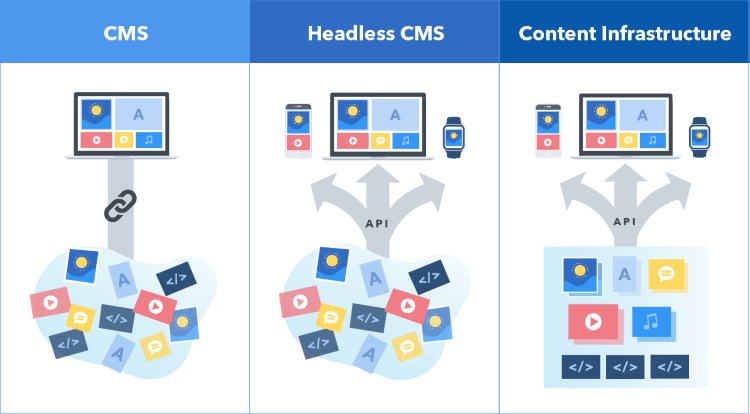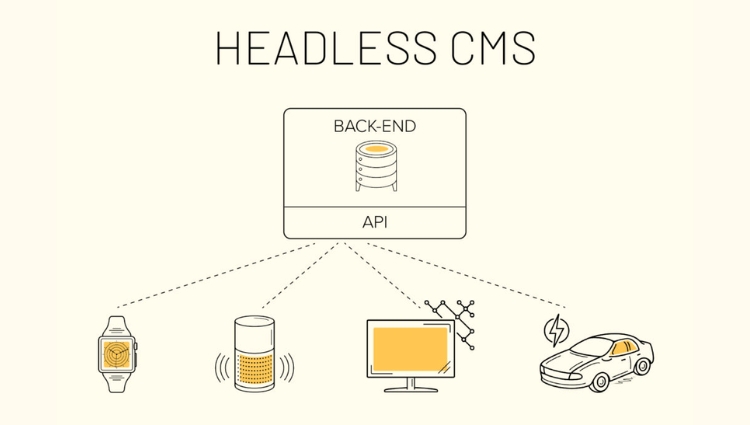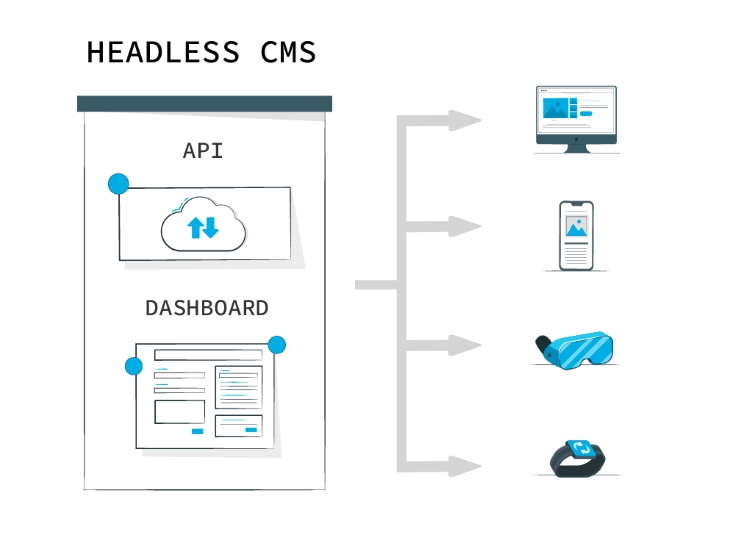Navigating the complexities of modern digital delivery requires flexible and powerful content infrastructure. A Headless CMS offers a revolutionary approach, decoupling content from its presentation to empower both developers and marketers. This guide explores what a headless CMS is, its core mechanics, and why it represents a significant evolution in managing digital content across diverse platforms and devices.
What is Headless CMS?

A Headless CMS is a content management system that provides a backend where content is stored and managed, acting purely as a content repository without a predefined frontend or presentation layer.
Think of it like a body (the backend) that stores all the organs and functions (your content and its management tools), but has no head (the website or app where content is displayed).
The core idea is decoupling the content creation and storage from the way it is presented to users across different digital channels. This separation offers significant flexibility in how content is delivered.
Instead of rendering content directly into a webpage using templates, a headless CMS delivers raw content data via APIs (Application Programming Interfaces). APIs are sets of rules that allow different software applications to communicate with each other.
This means your content is not tied to a specific website template or technology. It sits in the headless CMS ready to be accessed and displayed by any “head” – be it a website, mobile app, smart watch, or any other digital screen.
In contrast, a traditional CMS tightly bundles the content management backend with a specific frontend presentation layer, often limiting where and how content can be published effectively.
Key components of a headless CMS include the content repository (database) and an API layer (like REST or GraphQL) to access and deliver content programmatically.
This architecture fundamentally shifts content delivery, enabling true omnichannel experiences where the same content can be seamlessly published and adapted across various platforms simultaneously.
The flexibility provided by this decoupled approach allows developers to use their preferred technologies for the frontend, leading to faster development cycles and more dynamic user experiences.
Headless CMS vs. Traditional CMS: Understanding the Difference
Understanding the distinction between a headless CMS and a traditional CMS is crucial for appreciating the benefits of the headless approach. The primary difference lies in their architecture and how content is managed and delivered.
How Traditional CMS Works
Traditional CMS platforms, like WordPress or Drupal out-of-the-box, are built as monolithic systems. The content database, the administration panel for managing content, and the presentation layer (themes and templates) are all tightly integrated within a single application.
When a user requests a webpage, the traditional CMS retrieves the content from the database, applies it to a predefined template using server-side rendering, and then delivers the fully formed HTML page to the user’s browser.
Content creators using a traditional CMS typically work within a “what you see is what you get” (WYSIWYG) editor. They build pages that are visually tied to the website’s design, which is controlled by the chosen theme or template.
This coupled architecture works well for delivering content to a single website. However, publishing that same content to other platforms, like a mobile app or a digital display, often requires manual effort or separate systems.
Updates to the CMS or the website’s design can sometimes impact content delivery. The tight coupling means changes in one area can necessitate adjustments in others, potentially slowing down development and iteration.
Security updates and maintenance for the entire monolithic application are necessary. This requires managing both the backend and the frontend within the same system, potentially increasing the attack surface.
How Headless CMS Works
A headless CMS adopts a decoupled architecture. It strictly separates the backend content management and storage from any specific frontend presentation layer.
The backend provides an interface for content creators to structure and input content. This content is stored in a pure, raw format within the content repository, independent of how it will eventually look.
Content is made accessible through APIs. Developers use these APIs to pull the content into any frontend application or device they are building.
This means developers have complete freedom over the presentation layer. They can use any programming language, framework (like React, Vue, or Angular), or technology stack they prefer to build the user interface.
The headless CMS is solely responsible for storing and delivering content. The frontend application is responsible for retrieving the content via API and rendering it for the specific channel.
Content is structured in a channel-agnostic way. A piece of content, such as a product description, can be created once and then seamlessly reused across a website, a mobile app, an in-store kiosk, and other digital touchpoints.
Updates to the headless CMS backend or the independent frontend applications can often happen without directly affecting the other. This allows for more agile development and faster deployment cycles.
Key Differences Summarized
The fundamental difference lies in architecture: Traditional CMS is coupled; Headless CMS is decoupled. This impacts content delivery.
Traditional CMS delivers content primarily as fully rendered pages via templates, limiting flexibility. Headless CMS delivers raw content data via APIs, enabling deployment anywhere.
Frontend control differs significantly. Traditional CMS ties content to specific themes and templates, restricting design freedom. Headless CMS provides complete freedom over the frontend technology stack.
Omnichannel support is a key differentiator. Traditional CMS struggles with seamless multi-channel delivery. Headless CMS is built for native omnichannel content distribution.
Updates and maintenance in traditional CMS can be more rigid due to the coupled nature. Headless architecture allows for more independent and flexible updates of the backend and frontend.
Technology stack freedom is a major benefit of headless. Developers are not restricted by the CMS’s built-in technologies and can use modern frameworks for the presentation layer.
Key Benefits of a Headless CMS

Adopting a headless CMS offers numerous advantages that address the challenges of modern digital content delivery. These benefits impact various roles, from developers to marketers and business leaders.
Enabling Omnichannel Content Delivery
A primary driver for adopting headless CMS is the increasing need to deliver consistent content across a multitude of digital channels. Users interact with brands through websites, mobile apps, social media, email, IoT devices, and more.
Traditional CMS often requires significant effort or separate systems to adapt content for each channel. A headless CMS solves this by storing content in a raw, structured format, ready for distribution anywhere via API.
Content created and managed in the headless CMS becomes a single source of truth. This ensures consistency in messaging, branding, and information regardless of the platform the user is engaging with.
For example, a retailer can manage product information (descriptions, images, pricing) centrally in a headless CMS. This single source of data can then power their e-commerce website, mobile shopping app, and digital displays in physical stores.
This unified approach eliminates content silos and reduces the manual effort required to maintain content across disparate systems. It allows marketing teams to launch campaigns simultaneously across all relevant channels efficiently.
Seamless omnichannel delivery improves the customer experience. Providing consistent, up-to-date information wherever the customer chooses to interact builds trust and strengthens brand perception.
Increased Flexibility and Developer Freedom
Headless CMS provides developers with unparalleled flexibility. They are no longer restricted by the templates, themes, or programming languages dictated by a traditional CMS.
Developers can choose the best tools and frameworks for building the frontend of each specific project. This might involve using React for a dynamic web application, Swift for an iOS app, or Kotlin for an Android app.
This freedom accelerates the development process. Developers can work with technologies they are proficient in, leading to more efficient coding and faster iteration cycles for digital experiences.
It also future-proofs the content infrastructure. As new devices and digital platforms emerge, the content in the headless CMS can be accessed via API and presented on these new “heads” without migrating the entire content system.
Frontend and backend teams can work independently and in parallel. Content creators can focus on managing content while developers build and optimize the presentation layers, reducing dependencies and bottlenecks.
This separation encourages innovation in user experience design. Developers are free to implement cutting-edge technologies and create highly interactive and personalized interfaces without being constrained by CMS limitations.
Improved Performance and Scalability
Decoupling the presentation layer from the content repository can significantly improve application performance. Traditional CMS often involves server-side rendering and can be bogged down by themes and plugins.
With a headless CMS, the frontend often fetches content via fast APIs and handles rendering on the client-side or through modern techniques like static site generation (SSG). This can lead to much faster page load times, crucial for user experience and SEO.
Scalability is also enhanced. The content management backend and the frontend delivery layer can be scaled independently based on demand. If website traffic spikes, you can scale the frontend without impacting the content repository.
Similarly, if the volume of content and content creators increases, the backend can be scaled without affecting the performance of the live digital channels. This provides greater resilience and cost-efficiency in scaling resources.
Leveraging CDNs (Content Delivery Networks) for content delivery becomes more straightforward. APIs can serve content to CDNs, which cache and distribute it from servers closer to users, further reducing latency and improving speed globally.
This architectural advantage in performance and scalability supports business growth. It allows organizations to handle increasing traffic and content demands without requiring a complete system overhaul.
Enhanced Security
Separating the frontend from the backend can contribute to a stronger security posture. In a traditional CMS, the database and presentation layer are often exposed on the same server, increasing the attack surface.
With a headless CMS, the administration interface and content repository can be hosted and secured separately from the public-facing frontend applications. This reduces the risk of direct attacks on the content itself.
APIs can be secured with various authentication and authorization methods, controlling who can access and retrieve content. This adds another layer of protection compared to directly exposing the content database.
Frontend applications built on modern frameworks often have fewer inherent security vulnerabilities compared to complex, plugin-heavy traditional CMS installations. Security efforts can be more focused on the API and the frontend applications.
Regular security updates can be applied to the headless CMS backend independently of the frontend, and vice-versa. This allows for more agile responses to potential security threats in specific parts of the system.
While no system is entirely immune, the architectural separation in a headless CMS provides inherent security advantages by reducing interconnectedness and allowing for more targeted security measures.
Streamlined Workflows and Collaboration
Headless CMS can significantly improve the efficiency of content workflows and team collaboration. By separating concerns, content teams and development teams can work more effectively.
Content creators and editors use a dedicated interface focused solely on managing content structure and input. They are not concerned with the presentation or technical implementation details.
This allows content teams to focus on creating high-quality, structured content that is reusable across channels. Their workflow is streamlined for content production and organization.
Simultaneously, developers can work on building and optimizing the frontend applications using their preferred tools. They consume content via the API, independent of the content creation process.
This parallel workflow reduces dependencies and bottlenecks that often occur in traditional CMS environments where frontend and backend development are tightly coupled. Teams can progress independently.
Content modeling, a key aspect of headless CMS, encourages planning and structuring content logically. This upfront planning improves content organization and makes it easier for both content creators and developers to work with.
Clearer separation of roles and responsibilities within teams fosters better collaboration. Each team can focus on its area of expertise while leveraging the headless CMS as the central content hub.
Core Components of a Headless CMS

Understanding the fundamental parts that make up a headless CMS is essential to grasping its architecture. These components work together to provide flexible content management and delivery.
The Content Repository
The content repository is the heart of a headless CMS. It is the central database where all digital content is stored. This includes text, images, videos, and any other digital assets.
A key feature of the content repository in a headless CMS is its focus on structured content. Content is organized into defined content models, rather than being freeform text within a page template.
Content modeling involves defining the types of content you will manage (e.g., “Article,” “Product,” “Author”) and the fields associated with each type (e.g., for “Article”: Title, Author, Body Text, Featured Image, Publish Date).
This structured approach ensures content is organized logically and is easily accessible and reusable via API. It makes content channel-agnostic, as its structure is independent of its presentation.
The content repository provides the interface for content creators to add, edit, and manage content based on these defined models. This interface is typically user-friendly, focusing solely on content input and organization.
Storing content in a pure, raw format ensures its long-term usability. As new technologies and channels emerge, the content remains compatible and can be easily adapted for new presentation layers.
The API Layer
The API layer is the crucial bridge between the content repository and the various frontend applications that consume the content. It allows developers to access and retrieve content programmatically.
Most headless CMS platforms provide APIs, commonly RESTful APIs or GraphQL APIs. These APIs define how applications can request and receive content data from the repository.
Developers send requests to the API to fetch specific pieces of content based on criteria like content type, ID, or filters. The API then returns the requested content, typically in a structured data format like JSON or XML.
REST APIs are a common choice, providing a standardized way to interact with resources using HTTP requests (GET, POST, PUT, DELETE). GraphQL is gaining popularity for its efficiency, allowing clients to request exactly the data they need.
The API layer is responsible for handling authentication and authorization, ensuring that only authorized applications and users can access the content.
This programmatic access to content via API is what enables the flexibility and omnichannel capabilities of a headless CMS. Any application capable of making API calls can become a “head” for the content.
Developers interact with the API to build the user interface and display the content according to the design and requirements of each specific channel, completely independent of the backend content management system.
Is a Headless CMS Right for Your Project?
Deciding whether a headless CMS is the right fit depends on your specific project requirements and technical capabilities. It offers significant advantages, but also introduces certain considerations.
If your project requires delivering content to multiple diverse channels beyond a single website, a headless CMS is likely a strong candidate. Its native omnichannel capabilities simplify this process significantly.
Projects that prioritize performance and scalability can benefit greatly from the decoupled architecture. The ability to optimize the frontend independently and scale components separately supports high-traffic applications.
Organizations with dedicated development resources comfortable working with APIs and building custom frontends are well-positioned to leverage a headless CMS. It requires more frontend development effort compared to a traditional CMS.
If your team requires complete control over the frontend technology stack and desires the flexibility to use modern frameworks, a headless CMS provides that freedom without being constrained by built-in themes.
For simple websites with minimal need for multi-channel delivery or complex integrations, a traditional CMS might offer a faster and simpler initial setup due to its integrated templates and visual editing capabilities.
Consider the long-term goals for your digital presence. If future expansion to new devices and platforms is anticipated, investing in a headless architecture can provide the necessary flexibility and future-proofing.
Conclusion: The Future of Content Management
Headless CMS represents a significant evolution in content management architecture, moving beyond the limitations of traditional, coupled systems. By decoupling the content repository from the presentation layer, it offers unparalleled flexibility, scalability, and the ability to deliver content across the ever-expanding digital landscape.
The API-first approach empowers developers to build innovative and high-performing frontend experiences using their preferred technologies. Simultaneously, it provides content creators with a streamlined platform focused on structured, reusable content.
As user interactions become increasingly fragmented across various devices and platforms, the ability to deliver consistent and tailored experiences is paramount. Headless CMS provides the foundational infrastructure to meet this demand effectively.
For businesses seeking agility, control over their technology stack, and a future-proof approach to digital content, understanding and potentially adopting a headless CMS is a critical step in navigating the future of online presence and customer engagement.
Implementing a flexible Headless CMS requires dependable, high-speed infrastructure. For a quality foundation, Quality Vietnam VPS offers a stable, high-end platform utilizing new generation dedicated hardware including AMD EPYC Gen 3th processors and SSD NVMe U.2. This provides a strong configuration with optimized capacity and high bandwidth for reliable, high-speed performance.
